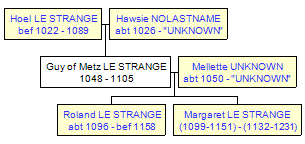Guy of Metz LE STRANGE1,5,3,4
also known as 5
also known as 5
10481,2,3,4 - 11051,2,3,4
Life History
1048 |
Born in Norfolk, England.1,2,3,4 |
about 1096 |
Birth of son Roland LE STRANGE in Cheswardine, Shropshire, England.1,6 |
between 1099 and 1151 |
Birth of daughter Margaret LE STRANGE.7 |
1105 |
Died in London, England.1,2,3,4 |
Other facts
|
Married Mellette UNKNOWN |
Notes
- The Le Strange Website, focusing on the history and lineage of the Hunstanton Le Strange family, does not report any ancestors before Roland. In the discussion of origins, they give background of the three primary family lines that coalesced in Roland's line, but mention nothing about the legend of Guy or his father Hoel (Howell). Other genealogies and some histories refer to Guy a real person, attempting to separate him from the romance of legend that developed around him in the stories of his grandson descendant.
Guy is said in legend to be from Metz. A 12th century romance portrays him as the son of the Duke of Brittany. (Compare likewise Guy's father Hoel Le Strange, whom some undocumented genealogies have tried to identify with Hoel V, County of Cornouaille in Brittany. These are normally undocumented and from a research verification point of view are not confirmed, and seem fanciful.)
Guy's wife Mellette may be a true figure, so I have made her his wife. Sources, however, report his parents as Hoel (Howell) and Hawsie (sometimes found as Hawise). The bulk of the following presentation of the legend comes from the Le Strange Family Genealogy on the Hart Family Web Site, whose Corbet-Le Strange genealogy I have used as one basis for the family lines of this period.
The legend bears many of the common characteristics of medieval romances, which were fanciful and mystical or flighty. These were composed for entertainment, but sometimes incorporated what moderns would consider actual "facts" about the characters involved. I have edited the story for grammar and form, and expanded it slightly here to include some cultural and historical clarification, for inclusion in my genealogy. -- OBJ
=============================================
The le Strange legend that has been repeated through successive generations can be found in part of an epic tale, the "Romance of Fouke le fitz Warine." This French prose, which was written by an unknown author in traditional trouverian [troubadourian] style of the 13th century, was translated and reproduced in early medieval times for its popularity gained by the declared outlaw.
Fulk is otherwise known as Fulk the son of Warine II. Warine is a form of the older Guarine, which came to be Warrenne, then Warren in English usage. Compare the development of the Germanic name Gwillam, as Guillaume in French spelling, and William in English, and Guillermo in Portuguese or Spanish.
This latter name has a great variety of spelling throughout its history of usage in virtually all the languages of Europe through the pervasive presence of the Normans in every royal house of Europe, including Russia and Eastern domains.
The story of Guy and Fulk is a story set in the 11th century A.D. where it begins with a certain lady, Mellette, who features as the outlaw's grandmother. In her youth, Mellette was united with her husband Guy of Metz, who otherwise was known in France from whence he came, as Guarine or Warine de Metz.
The chapter conveys how the le Strange family was founded, prior to the Warines, when Mellette, a beautiful damsel has a jousting tournament arranged for by her wealthy uncle, William Peverel. This was held in the time of William the Conqueror, in 1083 at his Castle Peveril (Peverel) in the Peak of Derbyshire England, and this is where she was expected to find a suitable husband, to which she replied:
------------------------------------
"Sire, no knight is there in all the world that I would take for the sake of riches and the honour of this land but if ever I take such a one he shall be handsome and courteous and accomplished and the most valiant of his order in all Christendom. Of riches I make no account, for truly can I say that he is rich who has that which his heart desires."
-- from: Mellette, "The Romance of Fouk le fitz Warine"
------------------------------------
Noblemen eager to win her as their bride -- together with dowry including the attractive white tower of Whitetown, known as Whittington Castle Shropshire -- came from every corner; Scotland, Wales and France. The two most salubrious guests, Owen Prince of Wales, and Eneas, Prince of Scotland, brought 200 knights along.
The Duke of Burgundy outnumbered them with a hundred more. Ydromor, Prince of Galloway came with a modest 150 men, but Guy (Guarine de Metz France ), son of John, Duke of Brittany, (Johan duc de la Petite-Bretagne), came with only a hundred, plus his 9 brothers.
Ultimately, Guy, with his life spared, victoriously claimed his wife, Mellette, who had already expressed her interest in him by sending over her glove. It continues... "..... Guy remained in England, and conquered, by the force of his sword, many beautiful lands, and so was named Guy le Strange ...."
For more information see the "http://www.renderplus.com/hartgen/index.htm"
-- Our Folk -- Hart family Web Site
=============================================
Sources
- 1. Our Folk, Albert D Hart
- http://www.renderplus.com/hartgen/htm/le-strange.htm
- 2. Strange Genealogy
- http://thor.genserv.net/sub/strub/fam_162.htm
- 3. Le Strange GeneaNet
- 4. Our Folk, Albert D Hart
- 5. Ancestry Stories
- 6. Senderling Genealogy
- Name: Name: http://www.freemarket-phone.com/dat111.htm;;
- 7. World Family Tree Vol. 14
- Pedigree #3302
